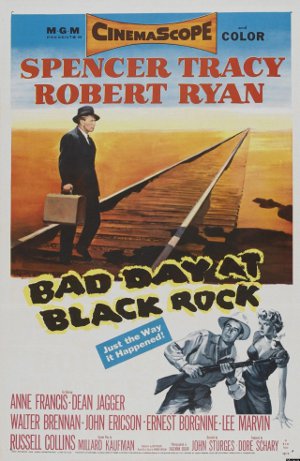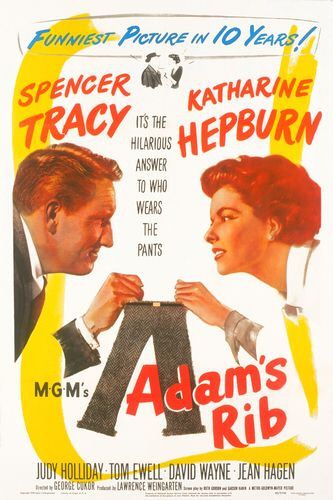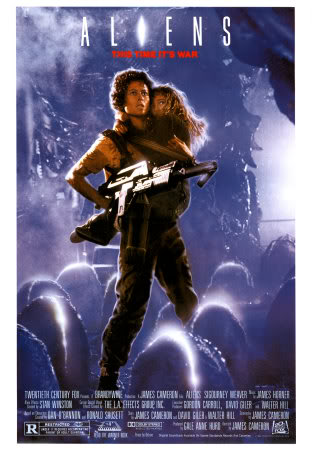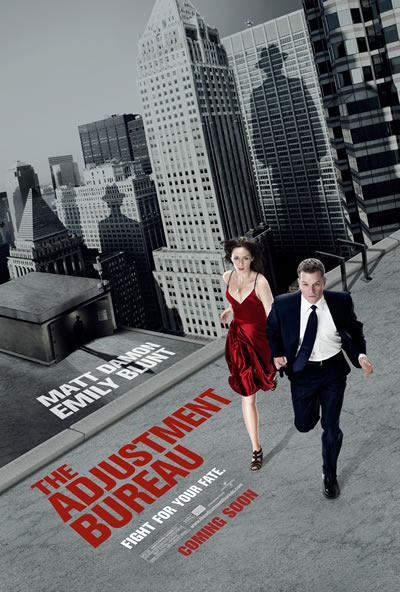
Here, for those who don’t know, is the movie retelling of the Watergate saga. I added this to the list on my own because I read the book in 2007 and liked it so much. (I also bought the DVD probably over a year ago somewhere, I’m sure I just found it cheap, and had never watched it.)
The story is quite successful in terms of emotional power. What begins as a simple investigation into some numbskulls who got caught breaking into a political office spirals credibly to the highest reaches of power in America, and the fate of the Constitution and the country depend on the power of two inexperienced but driven reporters, Bob Woodward and Carl Bernstein. (Here’s what they look like in real life.) As one of the interviewees in the making-of featurette on the DVD said, Hollywood couldn’t have made up this story.
Sequence: burglars caught
- President Nixon returns from China; addresses Congress
- Burglars caught at Watergate office building
Sequence: B, W placed together on story
- Woodward assigned to cover arraignment of Watergate burglars; finds out they have worked for CIA, their attorney Markham is evasive and doesn’t explain why he’s there
- Woodward links burglars to Hunt, Hunt distressed.
- Post editors debate whether to give story to more senior reporters, Harry keeps it with Woodstein
- Woodward and Bernstein pair up on story
Sequence: first story not successful
- Bernstein finds out from girl that Hunt was researching Ted Kennedy
- Woodward & Bernstein encounter senseless lying and denial from White House librarian and Ken Clawson about Howard Hunt
- Try to investigate Hunt’s Library of Congress records, but his history has been removed from records
- Bradlee cuts down their story on Hunt, not enough hard information
Sequence: W gets DT as source
- Woodward tries to call Deep Throat for help on investigation, DT does not talk on phone but gives him instructions on meeting in person secretly
- Woodward meets with DT in parking garage, DT says to follow the money
Sequence: W,B successfully connect money to Stans
- Bernstein goes to Miami, waits all day outside office then finally gets to look at records and finds name of Kenneth Dahlberg
- W calls Dahlberg, KD very upset, but reveals that he gave cashier’s check to Stans; big story for W and B
Sequence: editors doubt story
- Editors at Post are partially against the Watergate story, think it’s too incredible to be true, very dangerous for paper
- Bradlee questions W and B why he should continue with the story
Sequence: failures trying to talk to CREEP employees
- W,B get list of CREEP employees from woman
- Go to Betty Miland’s home, she is unhappy they are there, afraid of being watched, but does talk about document shredding that took place under John Mitchell’s supervision
- Get turned away by everyone they try to talk to, the people seem to be under pressure not to talk to them. One woman finally does talk to them happily, turns out to be a mistaken identity, isn’t connected to story
- W,B stuck. Find out from Harry next day that GAO report they were counting on postponed
Sequence: Finally get good information from a bookkeeper
- B interviews a bookkeeper, she nervous, but gives him a lot of info, initials of men who controlled cash fund
- WB devour information, make plan to go back to her and trick her into giving names
- Trick works, she gives them several more names
Sequence: Run explosive story on John Mitchell
- In reaction to story, Attorney General admits he did not know about paper shredding after Dept of Justice investigation
- Sloan tells W,B fund was about $1 million, won’t give last two names
- Bradlee angry that WB don’t have any on-the-record sources. B calls Mitchell, gets negative reaction quote to story
- Bradlee talks with WB, asks for more detail on DT, tells them to run Mitchell story
- Next day, they watch on TV Spiro Agnew’s “non-denial denial” response
Sequence: Interview Segretti, pressure increasing
- B’s FBI friend Joe tells him FBI is wondering how WB getting their info, then tricks B into being photographed
- B has break in case re: Donald Segretti
- Segretti reveals more of CREEP’s strategies
- DT tells W they are getting close to bringing the scandal inside the WH, interrupted by screeching car leaving garage, W, paranoid, walks all the way home
Sequence: Ken Clawson Canuck letter story
- Sally tells WB that KC wrote Canuck letter, KC non-denies, then begs Bradlee not to print that he was at Sally’s apartment
Sequence: Haldeman story inaccurate
- WB try to get confirmation from Sloan on Haldeman’s involvement, Sloan gives roundabout affirmation
- Bradlee forces them to get another source on Haldeman, B gets flimsy confirmation from Justice source, story runs
- Barrage of denial next day: misstep
Sequence: DT warns them they are under surveillance, now in danger
- Joe won’t talk to WB, they suspect they were set up
- W meets with DT, DT says their lives are now in danger, then gives a load of info and direction
- W tells B they are in danger, under surveillance and bugging; B tells W that they were right that Haldeman was involved, but it turns out that the FBI did not investigate Haldeman at all
- W,B talks to Bradlee, he tells them they are in danger, the future of country depends on their work, go sleep then get back to work.
Sequence: working while no one else does, they close the case on Nixon
- As time rolls on, they sit at their desks typing and typing. Later headlines shown on screen, Nixon eventually resigns in 1974
Technicals/Overall Story Structure
The central plot is that of Woodward and Bernstein working to uncover the truth in the Watergate affair. One subplot is the conflict between the editors and the reporters of the Washington Post over the importance of the story: whether it should be given to another reporter and whether it is worthwhile for the paper to pursue it at all. Another subplot is that of Woodward and Bernstein learning to work together as a team.
The controlling idea is “With great effort and care, the truth may be discovered.”
The inciting incident comes in two parts: first, when the burglars are caught by the police, and then when Woodward is assigned to cover the story. Regarding the obligatory scene and climax, see the “ending” section below.
This story, as you see, I broke down into sequences, but not acts. Once I watched it a second time and looked over my notes, I find any meaningful act divisions. I am quite happy to hear what anyone else makes of this, but my conclusion is that three-act structure doesn’t really fit this story.
What we have instead are a series of “movements” back and forth. Once the story gets started, this cycle essentially repeats: Woodward and Bernstein search for more clues, encounter difficulty, figure something out, write a story, then repeat. Roger Ebert, in fact, criticizes the movie over this:
All of these elements in “All the President’s Men” are to be praised, and yet they don’t quite add up to a satisfying movie experience. Once we’ve seen one cycle of investigative reporting, once Woodward and Bernstein have cracked the first wall separating the break-in from the White House, we understand the movie’s method. We don’t need to see the reporting cycle repeated several more times just because the story grows longer and the sources more important. For all of its technical skill, the movie essentially shows us the same journalistic process several times as it leads closer and closer to an end we already know.
I have done some reading lately on criticism of the three-act structure (namely, these articles, linked from here: one, two, three, and four). To these writers, the supposed three-act structure of a screenplay is a relic of writing for the theater, but makes no sense for film, and is the cause of many problems for screenwriters who try to hew to it at the expense of understanding their story on its own unique terms.
To keep my commentary on this point brief, I agree that the three-act structure is not right for all films (present film being an example), but it is a useful general template for a feature film, and it is up to each writer to figure out how to apply it and vary it if needed. Besides that, based on everything I’ve heard, three-act is the standard in film writing today. Whether these critics like it or not, it’s what’s in use by the great majority of writers, and it seems to be doing okay. If a screenplay is poorly written, I would argue that the problem is not that the writer used a flawed model but rather that the writer was not imaginative enough overall.
The story does range through four variations on the primary story value, truth. In the positive form, we have truth itself. The obvious negative of this is falsehood: all the denials and lies told by the president’s men. The contrary position is indifference: an unwillingness by some at the paper to pursue the story, and ignorant disbelief by seemingly the whole public. Lastly, the negation of the negation is the coverup of the truth perpetrated by Nixon and the FBI and Department of Justice–an obfuscation of reality deeper than Woodward or Bernstein could have ever imagined when embarking on the story.
Besides truth, the story also pivots on their own personal safety. Throughout most of the film, they are safe, unthreatened. Paranoia starts creeping in, providing a contrary feeling to their safety. Finally at the end, personal harm becomes a real threat, providing a negative form of this story value. I cannot find a negation of the negation to this.
The ending
The most pressing question after watching this movie is “What’s with the ending?” All the President’s Men seems almost like a half-formed story, dropping out right when the stakes are raised to a new high. The plot of the movie involves Woodward and Bernstein digging deeper and deeper to discover the truth about the Watergate break-in. Logically, the audience would expect to see a climax where the reporters finally uncover a piece of evidence that undeniably reaches to the bottom of the Watergate plot: something implicating Nixon himself. Having obtained this evidence, in the resolution we would see the damning story run in the newspaper, and Nixon finally being forced from office. Yet the story brings us to a new high of antagonism then stops—we see them working at their typewriters, then a stream of headlines from the story culminating in Nixon’s resignation. Why did they do it this way?
To begin with, a couple of real-life limitations may have affected this choice. First, the story itself is huge, with a huge amount of detail and intricacy involved to tell it with justice. A key goal of the film, which I think they adhered to was authenticity—details of the true events were not changed to make a better Hollywood story. Yet it probably wouldn’t be possible to tell the whole story from burglary to Nixon’s resignation in the time of a feature film and still make you feel for the characters. The emphasis of this film was on the enormous volume of work that the investigation required of Woodward and Bernstein. Shrinking the whole story from top to bottom to fit in one film might unduly make it seem that they practically just waltzed from story to story until Nixon resigned.
Another restriction imposed by the real-life material was that Woodward and Bernstein’s investigative work occupied a secondary role after a certain point in the unraveling of the Watergate scandal. As depicted in the movie, the real life Watergate story was a battle of credibility for the Washington Post, as they carried the story virtually alone, while most outsiders, and even some other Post editors, doubted there was any truth to it. Woodward and Bernstein eventually won this battle for recognition, and the story became unignorable. From that point, the investigation was picked up by a Senate committee and special prosecutor. So from a certain perspective, All the President’s Men is the tale of Woodward and Bernstein’s fight to bring the matter to public attention, which was a success, and in this sense it’s logical to stop the action of the story at a point before Nixon resigns.
(I also may as well add that the book was written before Nixon resigned, and therefore does not include Nixon’s resignation either.)
Yet there ought to be other reasons why Pakula and Goldman stop the story where they do. Being told by Ben Bradlee that they need to get back to the office and work harder, knowing now that their lives may be in danger, does not equate to attaining their object of desire, the full truth. How can the film just drop off and leave us like that? Let’s analyze this by asking some strategic questions.
Is this an anticlimax? I would not call this an anticlimax so much as a “nonclimax.” Though all these dramatic terms are somewhat fuzzy and don’t fit onto any two original stories the same, an anticlimax requires an unforeseen resolution of the ending in “gentle” violation of the rules of the story. The only anticlimax I have up here to compare is Alice in Wonderland. In that film, Alice escapes from Wonderland by waking up from her dream. Although that could be considered a bit of a cheat, we are happy with it, because (a) we expect a happy ending, and could not plausibly see how Alice would get out of Wonderland alive through her own power, and (b) the revelation that Wonderland was all a dream actually makes sense of the possible story hole of how Wonderland can coexist with the real world. That’s not what’s going on here. Rather, it’s more like the climax was just skipped over.
Do we need to reevaluate what the movie is truly about, i.e., what the central plot is? It could be, for instance, that either the final Deep Throat meeting or the lawn scene with Bradlee is the climax of a story thread that I haven’t identified. Indeed, there are some aspects of the story where a definite, irreversible change takes place from the start to the end. The primary one is the crystallization of the Washington Post team. Woodward and Bernstein are a fractious duo at the beginning, and it takes a long time before they gain Bradlee’s trust and respect, but they certainly have done so in the final scene on Ben Bradlee’s lawn. Deep Throat, too, has been goaded into divulging more information, and sticking his neck on the line for them. So Woodward and Bernstein have definitely grown by the end, and built the kernel of support that they need to carry on. But this still doesn’t make the final revelation by Deep Throat a story climax. It could be read, I would argue, as a crisis event, forcing them to a final effort which ultimately succeeds, and in a way this is what happens. But again, the difficulty is that that success is off screen.
What is the resolution, if any, in the film? Factually, the resolution is there: we see that Nixon resigns. But is that all we need? Definitely not. If so, watching a documentary, or even reading the Wikipedia article, would be a better way to learn the information. Robert McKee says that story is a metaphor for life. The point of this story is not the specific facts of how Nixon lost his presidency, but how two young reporters struggled against all odds to uncover the facts. Truth vs. power; outsiders vs. the system. That is the reason we watch the movie, and is the reason it resonates with us. The mere facts relate to the specifics of the story to provide resolution, (and every story needs to have specifics), but they are not the same as an actual climax.
In spite of all this narrative semantics talk, though, arguably the only important question is whether the ending satisfies. Imagine if the movie Titanic brought us up to 20 minutes before the ship sank, and then returned to the present-day submarine and old Rose just says “And the ship went down and Jack froze to death. That’s it.” Not much payoff for all that was built up to. (That was a spoiler, by the way, in case you haven’t seen it.) That’s what resolution is about. It’s a lot like sex: we want a big climax, followed by a period of basking, and that’s it.
And my verdict is that this movie does not deliver that. It would have been a challenge to pull off, granted, butI think this movie really would have been better if it had a climactic scene and some kind of resolution. This film skips the obligatory scene, and you can’t do that, because that scene is obligatory.
How might it have ended better? As mentioned before, it would have perhaps been unfeasible to show them struggling all the way up to Nixon’s resignation, and we certainly wouldn’t want to see a “one year later” jump in time just to show them bringing down Nixon. In fact, such a definite and positive ending would probably be inappropriate for this film—a little too rosy, a little too “Hollywood.”
But an ending needn’t go that far to be satisfying. For example, a great deal is made in the film of trying to clinch someone “inside the White House,” namely Haldeman. For all that this is discussed and set up as a goal worth achieving, it never happens. A suitable ending could be made of finally cementing his involvement in the coverup, making clear the implication that this story was going to go all the way to Nixon. Just show the streams of water shooting out between the bricks of a dyke: total collapse is inevitable.
Despite all these reservations, I loved this movie, as I loved the book, and look forward to more from all the principals.









